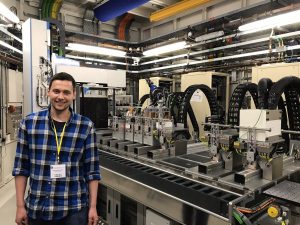Where are you from?
Born and raised in the heart of the Austrian alps, I had moved to Vienna in 2013 to study Earth Science.
What brought you to Cornwall / CSM?
After completing my studies with a Master’s degree in Mineralogy and Crystallography I was looking for Ph.D positions all over Europe without any geographical preference. I came across a Ph.D vacancy in Karen Hudson-Edwards group jointly between the University of Exeter/Diamond Light Source and ISIS Neutron and Muon Source. Karen has been very supportive right from the initial contact, never having been to England before I did some reading on Cornwall in general and Penryn Campus in particular, which convinced me that Cornwall/University of Exeter is a great place to pursue my Ph.D studies.
What’s the best thing about living in Cornwall?
The first year of this 4 year Ph.D program I had spent in Cornwall. Being based at ISIS Neutron and Muon Source in Oxfordshire since the start of 2020 I fondly recall going for a morning swim in summer before cycling to work, my trips to the Cornish countryside and wild camping in Dartmoor. Penryn campus is in close proximity (comfortable cycling distance) to Falmouth, a very vibrant town, and the perfect place to go for a pint after a long day spent in the lab.
What are your research interests?
The scattering of light when a mineral is irradiated with a laser is unique for every mineral and can be used a fingerprint to identify a mineral. To identify minerals by their spectral fingerprint one first must acquire a reference spectrum. Many sulfate minerals are sensitive to even smallest changes in air humidity or temperature, moreover, they may start to decompose when irradiated with a laser, which makes an unambiguous reference spectra collection very challenging. To tackle this problem, we are working with high-intense Neutrons and X-rays at particle accelerators and cross-check my results with computational modelling (Density functional theory). Once unambiguously acquired these reference spectra may find application various areas ranging from mine-waste management to space exploration. I am being supervised by Karen and Rich and what I am enjoying most is being involved in all steps of the experiment, right from the research idea, writing and submission of the beam-time proposal over to carrying out the actual experiment to the analysis and write-up of the data.
What’s your favourite mineral and why?
My favourite mineral is ice, since it forms beautiful hexagonal crystals, is a very refreshing coolant on a hot summer’s day and provides the perfect surface for loads of fun activities such as skiing or sledging.
